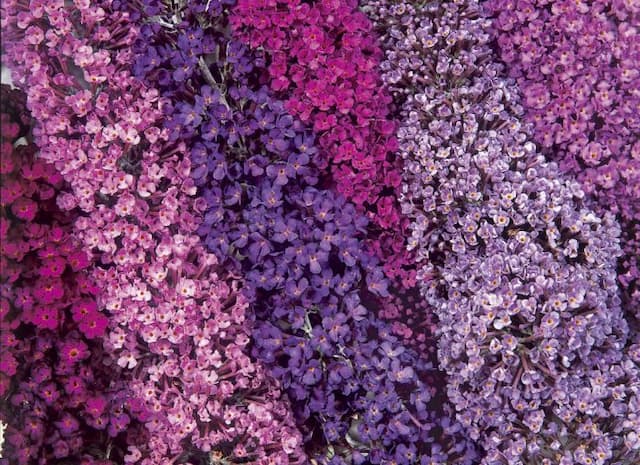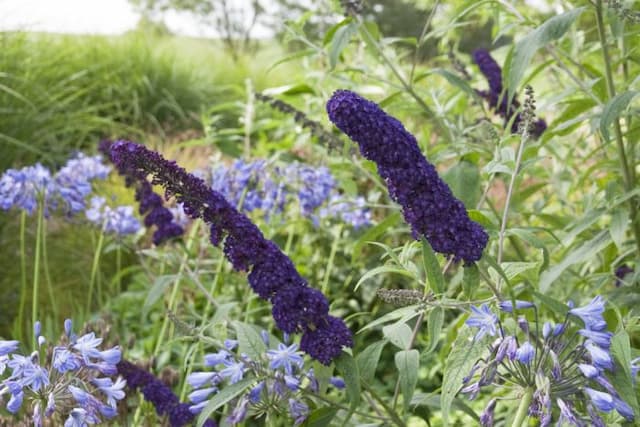Honeybells Freylinia lanceolata

ABOUT
Commonly known as the Honeybell Bush, Freylinia lanceolata is a visually appealing plant that stands out with its elegant lance-shaped leaves, which give it a delicate and structured appearance. The leaves are arranged neatly along the plant's branches, creating a dense foliage that is lush and often vibrant green, exuding a sense of vitality. Throughout the blooming season, the Honeybell Bush is adorned with tubular flowers, which are usually a captivating shade of blue or purple. These flowers are small but abundant, often covering the plant in a profusion of color that attracts various pollinators, enhancing the plant's ornamental value. The overall look of the Honeybell Bush is one of compact neatness and colorful charm, making it a popular choice for gardeners looking to add a touch of wilderness paired with orderliness to their landscape. The textured bark of the plant adds an additional layer of visual interest, often being a subtle contrast to the bright foliage. The harmonious combination of the Honeybell Bush's features results in a plant that is both eye-catching and elegant, typical of plants that are valued not only for their aesthetic appeal but also for their ability to thrive and bloom spectacularly with the right care.
About this plant
 Names
NamesFamily
Scrophulariaceae
Synonyms
Honeybell Bush, Blue Freylinia
Common names
Freylinia lanceolata.
 Toxicity
ToxicityTo humans
Honeybell Bush is not commonly listed as a poisonous plant to humans. There are no well-documented toxic effects or consequences of ingesting any part of this plant that I can provide. However, as with any plant, individual allergic reactions or sensitivities could occur, so it is generally recommended not to eat ornamental plants.
To pets
Honeybell Bush is not commonly known to be toxic to pets. There is no specific information suggesting that ingesting parts of this plant would cause symptoms of poisoning in domestic animals such as dogs or cats. However, it is always best to prevent pets from eating plants not specifically meant for consumption, as they could potentially cause gastrointestinal upset or allergic reactions in some pets.
 Characteristics
CharacteristicsLife cycle
Perennials
Foliage type
Evergreen
Color of leaves
Green
Flower color
Blue
Height
5 feet (1.52 meters
Spread
5 feet (1.52 meters
Plant type
Shrub
Hardiness zones
9
Native area
South Africa
Benefits
 General Benefits
General Benefits- Attracts Wildlife: Freylinia lanceolata is known to attract birds and beneficial insects such as bees to the garden, promoting biodiversity.
- Ornamental Appeal: It adds aesthetic value to a garden with its slender green leaves and masses of small, tubular flowers that are often blue or white.
- Low Maintenance: The plant is relatively easy to care for, requiring minimal maintenance once established.
- Drought Tolerance: It is tolerant of drought once established, making it suitable for xeriscaping and waterwise gardens.
- Wind Resistance: The plant is capable of withstanding windy conditions, making it useful for coastal landscaping and as a windbreak.
- Privacy Screening: Can be used as a hedge or screen to provide privacy due to its dense growth habit.
- Soil Adaptability: Freylinia lanceolata is adaptable to a wide range of soil types, provided they are well-draining.
 Medical Properties
Medical PropertiesThis plant is not used for medical purposes.
 Air-purifying Qualities
Air-purifying QualitiesThis plant is not specifically known for air purifying qualities.
 Other Uses
Other Uses- Hedge Plant: Freylinia lanceolata, commonly known as Honeybell Bush, is often used as a hedge or screen due to its dense and bushy growth habit.
- Windbreak: In windy areas, the Honeybell Bush can be planted as a windbreak to protect more delicate plants.
- Topiary Plant: Due to its dense foliage, the Honeybell Bush can be trained into topiary shapes for ornamental garden features.
- Noise Reduction: The thick foliage of the Honeybell Bush can help absorb sound, making it a good choice for planting along roads or in urban areas to reduce noise pollution.
- Erosion Control: The root system of the Honeybell Bush can help stabilize soil on slopes and prevent erosion.
- Biodiversity Supporter: The Honeybell Bush provides habitat and food for a variety of birds and insects, contributing to garden biodiversity.
- Privacy Screen: Its dense growth and height make the Honeybell Bush an excellent natural privacy screen for gardens and properties.
- Natural Fencing: When grown closely together, the Honeybell Bush can form a living fence that demarcates property lines or encloses garden areas.
- Seasonal Interest: Freylinia lanceolata showcases small, tubular flowers that add visual interest to gardens throughout various seasons.
- Background Planting: Due to its height and density, it serves well as a background plant in mixed borders, providing a backdrop for shorter, more colorful plants in the foreground.
Interesting Facts
 Feng Shui
Feng ShuiThe Freylinia is not used in Feng Shui practice.
 Zodiac Sign Compitability
Zodiac Sign CompitabilityThe Freylinia is not used in astrology practice.
 Plant Symbolism
Plant Symbolism- Adaptability: Freylinia lanceolata, commonly known as the Honeybell Bush, is known for its ability to adapt to different environments, symbolizing the capacity to adjust and thrive in variable conditions.
- Resilience: As a plant that can withstand various climates, the Honeybell Bush represents resilience and the strength to endure challenges.
- Radiance: The bright flowers of the Honeybell Bush signify cheerfulness and positivity, adding a splash of color and brightness to its surroundings.
- Healing: Associated with its use in traditional medicine, the Honeybell Bush can symbolize healing and the importance of health and well-being.
 Water
WaterThe common name for Freylinia lanceolata is Honeybells. When watering Honeybells, the soil should be kept moist but not waterlogged. Water the plant deeply once a week, providing about 1 to 1.5 gallons per session during the growing season. In the winter, reduce watering to every other week, using the same amount of water. Ensure proper drainage to prevent root rot, and during hot, dry spells, you may need to water more frequently.
 Light
LightHoneybells prefer a position where they can receive full sunlight to partial shade. A spot that offers morning sunlight with some afternoon shade would be ideal. Avoid deep shade, as it can lead to poor growth and fewer flowers.
 Temperature
TemperatureHoneybells thrive in a temperature range between 50°F and 80°F. They can tolerate minimum temperatures down to 30°F, but frost can cause damage. For optimal growth, maintain a consistently warm temperature without drastic fluctuations.
 Pruning
PruningPruning Honeybells is essential to maintain shape and encourage bushier growth. Prune in late winter or early spring, before new growth starts. Remove any dead or damaged branches and shape as desired. Pruning can be done annually or as needed for size control.
 Cleaning
CleaningAs needed
 Soil
SoilHoneybells (Freylinia lanceolata) thrive in well-draining, loamy soil with a pH range between 6.0 and 7.5. A mix of two parts garden soil, one part sand, and one part compost or peat will create an ideal growing environment for this plant.
 Repotting
RepottingHoneybells should be repotted every 2 to 3 years, or when you notice the roots have filled the current pot. It is best to repot in spring just before the growing season begins.
 Humidity & Misting
Humidity & MistingHoneybells prefer moderate to high humidity levels. Aim to maintain humidity between 40% and 60% for optimal plant health.
 Suitable locations
Suitable locationsIndoor
For indoor Honeybells, provide bright, indirect light and keep the soil moist.
Outdoor
Plant Honeybells in a sunny spot with well-draining soil and shelter from wind.
Hardiness zone
9-11 USDA.
 Life cycle
Life cycleFreylinia lanceolata, commonly known as the Honeybells, begins its life cycle as a seed, often dispersed by wind or animals. Upon finding suitable soil, the seed germinates, typically in spring or early summer, and a seedling emerges, growing primary roots and shoots. As the plant matures, it develops a woody stem and a bushy form, with lance-shaped leaves, reaching flowering maturity. During its flowering stage, usually in spring to summer, it produces tubular blue to white flowers that attract pollinators such as bees and butterflies. After pollination, the flowers develop into small capsules containing seeds, which are eventually released to start the next generation. The Honeybells is a perennial plant and can live for several years, going through repeated cycles of growth, flowering, and seed production.
 Propogation
PropogationPropogation time
Spring to Summer
Propogation: The Freylinia lanceolata, commonly known as Honey bell bush, is primarily propagated through semi-hardwood cuttings. The best time to take cuttings for propagation is during the late summer. Cuttings should be approximately 4 to 6 inches (10 to 15 centimeters) long and include several leaf nodes. The lower leaves are stripped off, and the cut end is often treated with a rooting hormone to encourage root development. The cutting is then placed in a well-draining medium such as sand or a sand and peat mixture, kept moist but not waterlogged, and covered with a plastic bag or placed in a greenhouse to maintain high humidity. Roots generally form within a few weeks, after which the new plants can be potted up into individual containers and gradually acclimated to outdoor conditions before planting out in the garden.


![Butterfly bush [Adonis Blue]](/_next/image?url=https%3A%2F%2Fplants-admin.emdemapps.com%2Fimages%2Fplants%2F%2Fimages%2F604b56e58f983.png&w=640&q=75)


![Butterfly bush [Buzz Ivory]](/_next/image?url=https%3A%2F%2Fplants-admin.emdemapps.com%2Fimages%2Fplants%2F%2Fimages%2F604b57987dfa8.png&w=640&q=75)
![Butterfly bush [Camberwell Beauty]](/_next/image?url=https%3A%2F%2Fplants-admin.emdemapps.com%2Fimages%2Fplants%2F%2Fimages%2F604b5ead04c12.png&w=640&q=75)


